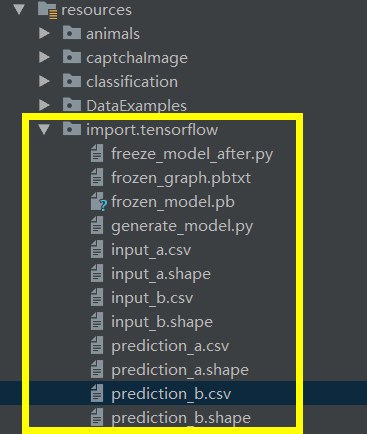Deeplearning4j - 使用nd4j导入tensorflow模型
在dl4j-example里面新增了模型导入的例子,这里简单的说一下。
在dl4j新版本的特性介绍:https://github.com/deeplearning4j/deeplearning4j-docs/blob/releasenotes_100a/releasenotes.md 中,对于nd4j的模型导入进行了特别强调。
ND4J: New Features
Technology preview of tensorflow import added (supports 1.4.0 and up)
其中一项就是对于tf模型的导入提供了功能预览版本,所支持的tf版本为1.4版本及其以上。
并于最近增加了导入tensorflow模型的示例代码,导入模型为 MINST 手写数字分类模型。从代码注释上面来看,因为是预览版本,目前只支持cpu运行,还不支持gpu的加速。
<center> 资源文件列表.png-23.3kB
资源文件列表.png-23.3kB
</center>
并且提供了如上的文件,用于本次示例的测试。
- freeze_model_after.py 和 generate_model.py 是生成模型的 python 文件。
- frozen_model.pb 为tensorflow的模型文件
- input_.csv 和 input_.shape为配套的特征数据文件。csv文件存放的是特征数据,一个特征一行;shape文件保存的是输入模型时的形状。
- prediction 文件同理,为预测的标签数据文件。
注: 使用该示例的时候,最好 IDE 已经安装了的相对的 lombok 插件。
资源文件夹
//Python code for this can be found in resources/import/tensorflow under generate_model.py and freeze_model_after.py
//Input node/Placeholder in this graph is names "input"
//Output node/op in this graph is names "output"
public final static String BASE_DIR = "import/tensorflow";
首先定义了一个根目录用于寻找对应的文件。
接下来在主函数中获取模型文件的绝对路径
final String FROZEN_MLP = new ClassPathResource(BASE_DIR + "/frozen_model.pb").getFile().getPath();
读取tf中的占位符输入
//Load placeholder inputs and corresponding predictions generated from tensorflow
Map<String, INDArray> inputsPredictions = readPlaceholdersAndPredictions();
这里面所用readPlaceholdersAndPredictions方法的全部代码如下:
//A simple helper function to load the inputs and corresponding outputs generated from tensorflow
//Two cases: {input_a,prediction_a} and {input_b,prediction_b}
protected static Map<String, INDArray> readPlaceholdersAndPredictions() throws IOException {
String[] toReadList = {"input_a", "input_b", "prediction_a", "prediction_b"};
Map<String, INDArray> arraysFromPython = new HashMap<>();
for (int i = 0; i < toReadList.length; i++) {
String varShapePath = new ClassPathResource(BASE_DIR + "/" + toReadList[i] + ".shape").getFile().getPath();
String varValuePath = new ClassPathResource(BASE_DIR + "/" + toReadList[i] + ".csv").getFile().getPath();
int[] varShape = Nd4j.readNumpy(varShapePath, ",").data().asInt();
float[] varContents = Nd4j.readNumpy(varValuePath).data().asFloat();
arraysFromPython.put(toReadList[i], Nd4j.create(varContents).reshape(varShape));
}
return arraysFromPython;
}
这段代码不难理解,就是把前缀为toReadList数组内容中的数据成对读取出来,并且转换成为INDArray对象,并且返回回去。
模型读取
//Load the graph into samediff
val graph = TFGraphMapper.getInstance().importGraph(new File(FROZEN_MLP));
这里面的 val 并非java 10提供的变量自动推断,而是 lombok 所提供的功能。
数据关联
//libnd4j executor
//running with input_a array expecting to get prediction_a
graph.associateArrayWithVariable(inputsPredictions.get("input_a"), graph.variableMap().get("input"));
这段代码是将从文件中读取出来的 input_a INDArray关联模型的数据。
模型预测
val executioner = new NativeGraphExecutioner();
val results = executioner.executeGraph(graph); //returns an array of the outputs
INDArray libnd4jPred = ((INDArray[]) results)[0];
System.out.println("LIBND4J exec prediction for input_a:\n" + libnd4jPred);
模型预测,并且获取模型的结果输出。并且将其打印到控制台上。
结果判断
if (libnd4jPred.equals(inputsPredictions.get("prediction_a"))) {
//this is true and therefore predictions are equal
System.out.println("Predictions are equal to tensorflow");
} else {
throw new RuntimeException("Predictions don't match!");
}
用于判断结果预测,和所给的标签是否相同
使用不同的API用于预测 input_b 的值
//Now to run with the samediff executor, with input_b array expecting to get prediction_b
val graphSD = TFGraphMapper.getInstance().importGraph(new File(FROZEN_MLP)); //Reimport graph here, necessary for the 1.0 alpha release
graphSD.associateArrayWithVariable(inputsPredictions.get("input_b"), graph.variableMap().get("input"));
INDArray samediffPred = graphSD.execAndEndResult();
System.out.println("SameDiff exec prediction for input_b:\n" + samediffPred);
if (samediffPred.equals(inputsPredictions.get("prediction_b"))) {
//this is true and therefore predictions are equal
System.out.println("Predictions are equal to tensorflow");
}
对模型进行新增op
//add to graph to demonstrate pytorch like capability
System.out.println("Adding new op to graph..");
SDVariable linspaceConstant = graphSD.var("linspace", Nd4j.linspace(1, 10, 10));
SDVariable totalOutput = graphSD.getVariable("output").add(linspaceConstant);
INDArray totalOutputArr = totalOutput.eval();
System.out.println(totalOutputArr);
这个代码的意思就是对原有模型添加新的操作。
- 首先使用
graphSD.var("linspace", Nd4j.linspace(1, 10, 10))获取[1,2,3 ... 10],10个整数的向量 -
graphSD.getVariable("output").add(linspaceConstant);将这个向量加入到模型的输出中。
整体输出
LIBND4J exec prediction for input_a:
[[ 0, 0, 0, 0, 0, 0, 0, 1.0000, 0, 0]]
Predictions are equal to tensorflow
22:39:16,498 WARN ~ No input found for Add and op name mmul
22:39:16,498 WARN ~ No input found for Add_1 and op name mmul
SameDiff exec prediction for input_b:
[[ 0, 0, 1.0000, 0, 0, 0, 0, 0, 0, 0]]
Predictions are equal to tensorflow
Adding new op to graph..
[[ 1.0000, 2.0000, 4.0000, 4.0000, 5.0000, 6.0000, 7.0000, 8.0000, 9.0000, 10.0000]]
在最后我们可以看到,因为增加了新的op操作, 模型的原本输出[[ 0, 0, 1.0000, 0, 0, 0, 0, 0, 0, 0]] 加上了[1,2,3 ... 10]就会变成对应的[[ 1.0000, 2.0000, 4.0000, 4.0000, 5.0000, 6.0000, 7.0000, 8.0000, 9.0000, 10.0000]]。
更多文档可以查看 https://github.com/sjsdfg/deeplearning4j-issues。
你的star是我持续分享的动力
代码地址已经放在github上面,自行下载即可: https://github.com/sjsdfg/dl4j-tutorials












网友评论